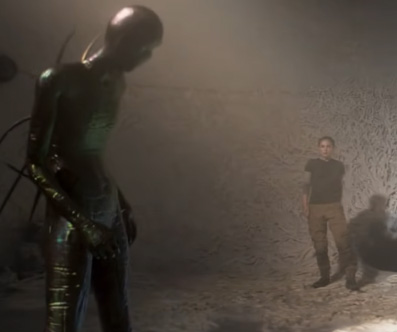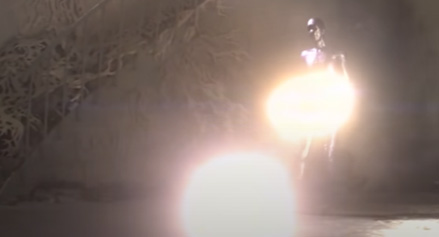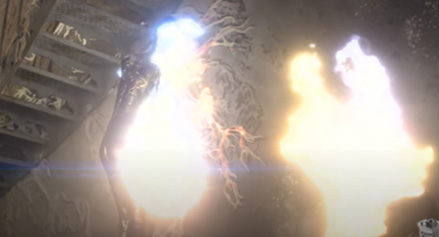How Can Machine Learning Help RF Propagation Analysis?
Share

MACHINE LEARNING IN CONTEMPORARY SCIENCE FICTION
2018 movie Annihilation is a science fiction movie about a mysterious area in the southern United States called The Shimmer. The Shimmer started to appear right around the time an identified object from outer space hits a lighthouse near the coastline. Within the Shimmer, rapid species mutation occurs, combining DNA of dissimilar species to make bizarre new species. A team of investigators is sent out to Shimmer, and on their way to the lighthouse they discover and fight grotesque and dangerous mutants. Once at the lighthouse, the protagonist named Lena (Natalie Portman), squares off against an alien spirit taking form of a threatening big humanoid:

As they start to fight, the humanoid gradually reduces in size, and starts mirroring Lena’s moves:

As the humanoid evolves, it starts to resemble Lena:


Sensing that she is in danger, Lena gives humanoid an incendiary bomb and activates it before running away. The humanoid has never seen an incendiary bomb, and instead of throwing it away it does the only thing it knows what to do: it duplicates the bomb, and throws the copy on the ground:


The humanoid keeps duplicating the bomb in hand, and soon it is engulfed in flames. The fire quickly spreads throughout the lighthouse, burning everything down and destroying the humanoid and the alien spaceship.
The alien humanoid is metaphor for Machine Learning algorithm. For ML to be successful in copying the living organism it needs a lot of data, and that data is Lena’s DNA. ML algorithm also needs time to compute optimum ML coefficients that shape Lena’s body, facial features, and fast track Lena’s moving in real time. However, the ML is not capable of making a good copy of Lena’s memories; when it is given a live incendiary bomb, it cannot rely on memory of Lena’s military training to decide what to do with it. Thus, it makes the wrong decision to copy the bomb instead of getting rid of it.
HOW DOES THIS RELATE TO RF SIGNAL PROPAGATION PREDICTION?
When applied to RF, the ML replicates RF channel between the transmitter (small cell) and the receiver (UE). The input data to ML algorithm can be grouped into 3 data sets:
- Transmitter data:
- Transmitter XYZ coordinates, transmitter power and frequency of operation, transmitter antenna pattern
- Environment data:
- XYZ coordinates, shape and material type of the obstacles between transmitter and receiver
- Receiver data
- UE location XYZ coordinates and RF signal level coverage map, obtained either by
- RF survey measurements (organic data) or
- RF simulation software (synthetic data)
- UE location XYZ coordinates and RF signal level coverage map, obtained either by
Based on the input data, the ML algorithm calculates ML coefficients and recreates RF signal level at UE. The accuracy of ML prediction is compared to the baseline (organic or synthetic data), and ML coefficients are optimized until the prediction error is minimized. Keep in mind that ML propagation algorithm is optimized for specific RF channel, just as the alien spirit optimized the humanoid form for Lena.
What happens when we make a change to input parameters? In general, the ML coefficients need to be recalculated to account for the change. However, some changes are more impactful than others. The change in output power or frequency of operation is not difficult to account for. This is a typical problem for multiband base stations/small cells, as cellular carriers operate at multiple bands. A more difficult problem is to move the transmitter to a different location. A change in the transmitter location changes the environment between the transmitter and UE. An ML algorithm trained on mostly Line of Sight environment would not do well when the small cell is moved to mostly Non-Line of Sight environment. Using an ML algorithm trained on LOS data to predict the NLOS coverage is akin to giving a humanoid a live incendiary bomb. Unlike in the movie there won’t be fireworks and explosions, but the total failure of RF coverage prediction is all but assured.
HOW ACCURATE IS ML PREDICTION?
ML accuracy is always worse than accuracy of the training data. Ideally, we would use only organic RF data to train ML algorithm; however, it is rare that we have enough survey data to do so. Most of the time, we use either synthetic RF data or combination of synthetic and organic training data. Synthetic data is less accurate than organic data, and when trained on synthetic data ML algorithm compounds two errors: the error of synthetic data compared to organic data, and the error of ML data compared to synthetic data. This is a tradeoff when using the ML algorithm for RF prediction; the prediction runs faster but is less accurate.
WHAT IS THE BEST USE FOR ML PREDICTION ALGORITHM?
If one has access to trained ML algorithms for various types of RF channels within a venue, one can simply apply ML algorithm for each transmitter in lieu of Ray Tracing and/or Vector Parabolic Equation simulations. While it takes time to train ML algorithm, reusing appropriate ML is very efficient. Thus, we can greatly reduce computation run time using ML compared to RT/VPE, as the latter must compute RF channel conditions for every transmitter.
The best strategy when designing a large multiband network is to use ML algorithm for preliminary cellular network design, when an RF engineer is still trying to find the optimum transmitter location to maximize the signal coverage. For the final design, the more accurate algorithms (RT/VPE) shall be used for propagation simulation. This methodology still significantly reduces the time to design very large networks, while maintaining the expected accuracy of the final design and final RF coverage maps.
- At a Glance: What Is New in Wi-Fi 7? - July 4, 2024
- Accurate Prediction Simplifies Private, In-Building 5G Network Deployments - March 1, 2023
- Accurate Network Design Needed to Harness the Full Potential of Metamaterials - February 20, 2023


















The Annihilation movie was the perfect analogy for machine learning. Had a nice time reading our article, Vladan.